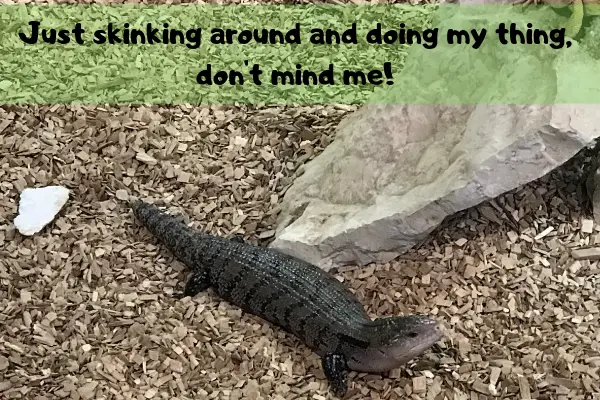When it comes to blue tongue skinks, there are a lot of things that are quite bizarre. That’s why we’ve created this list of some of the best blue-tongue skink facts.
This will help you to learn more about this animal and will help you to wow your friends next time one of these lizards pops up in a conversation!
Want to learn more about blue tongue skink care? Check out our blue tongue skink care guide!

Table of Contents
Blue tongue skink fact #1: There are multiple kinds of blue tongue skink!
When talking about the blue tongue skink, most people are referring to the Northern blue tongue skink. However, there are more varieties available in the pet trade.
For example, the Indonesian blue-tongued skink is a common skink circulating in the pet trade. This skink looks relatively similar to the Australian blue tongue skink, but it has some different needs when it comes to their care.
This can cause problems with pet owners thinking they have one species when they really should be providing the husbandry for the other species.
fact #2: They give birth to live young!
Blue-tongued skinks actually give birth to live young! This is extremely unusual for reptiles and makes them a very unique species. There are only a hand full of reptiles that give birth to live young. For more information about this topic regarding snakes, check out our post called “do snakes lay eggs?“
The egg actually hatches internally after which the live baby is born. This isn’t always the case with reptiles that birth live young though…
These skinks are also notoriously hard to breed and give birth to a reasonably small number of young compared to other reptiles. This often causes shortages in the pet trade which causes the price to rise.
fact #3: They’re scavengers!
These little critters are actually scavengers! In the wild, they have been known to feed off of garbage, dead meat, and even other animals’ poo!
This often causes issues with pet owners providing blue tongued skinks with the wrong kinds of foods. People have the tendency to think like a human when feeding their skink instead of thinking like a skink which can cause skinks to receive a poor diet (even though it seems like a good diet to us!).

fact #4: They love dog food and cat food
Blue tongue skinks are often fed dog or cat food as it has shown to be the most effective diet for these animals.
This is another thing that often trips up pet owners. They want to provide an authentic life for these little scavengers, but in reality, “natural” and “fresh” aren’t words that these animals understand.
People trying to impress their own opinions onto their skink is often a cause of malnourishment and even death among blue tongue skinks.
Fact #5: Why they have a blue tongue!
The blue tongue that these skinks have is thought to prevent the skink from burning its tongue.
However, there are also theories suggesting it is used to scare off potential predators. Unfortunately, google translate doesn’t speak skink so we can’t ask them if it helps them with the sun, or if it’s effective at dealing with predators…
Fact #6: They don’t drop their tail easily
Blue tongue skinks are much less likely to drop their tail than most other lizards. This makes them a little easier to handle but it’s still advised to be careful with their tail.
Tail dropping is a common defense mechanism that reptiles use to keep predators off them. When a predator grabs their tail they can drop it so that they can escape.
Unfortunately, the tail often grows back in a rather unpleasant-looking way, so skinks not dropping their tail as easily is great!
Fact #7: All skinks are shaped weird
Blue tongue skinks come from a line of lizards that are almost all just as peculiarly shaped as the blue tongue skink!
There are even certain lizards that don’t have any legs and move in the same way that snakes do! These are called legless lizards and look even stranger than blue tongue skinks do!
Fact #8: They’re one of the best pet reptiles!
Blue tongue skinks are one of the best reptiles to keep as pets. They are calm when being handled and are in extremely high demand.
They are extremely popular and this often results in relatively high-prices in certain regions.
Want to learn more about the best pet reptiles? Check out our post on the best reptiles to keep as pets!
Fact #9: A lot of them in the pet trade are wild-caught
Due to the high demand and relatively low level of supply, there are a lot of wild-caught skinks on the market. This can cause issues with parasites and illnesses and may lead to you buying a skink that’s not in optimal health.
As well as this, there are a lot of ethical issues people have with keeping wild-caught skinks. Therefore, it’s always best to do some research on the place where you’re going to buy your blue tongue before purchasing.
Fact #10: They have multiple names!
Both the terms blue tongue and blue-tongued are used to describe these skinks. We’ve been using them interchangeably throughout this blog post… Did you notice?
Fact #11: They have a third eye!
Blue tongue skinks have a third eye on the top of their head they use to monitor light levels above them. It has been proven that this third eye is used for things like directional awareness, as well as seeing predators and dangers from above.
This eye isn’t fully developed though, so it only detects light or dark and doesn’t form an image like their normal eyes can.
Conclusion
As you can see, there’s a lot more to these quirky-looking lizards than first meets the eye. They’re a very unique species of lizard and make for wonderful pets.
Next time these lizards feature in a conversation with your friends or family you’re now ready to wow them with some interesting facts. Enjoy the rest of your day and remember to keep herping!
